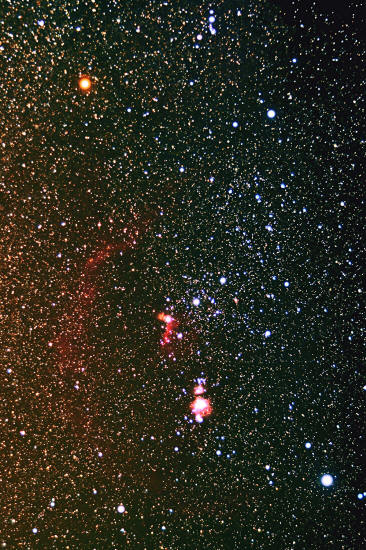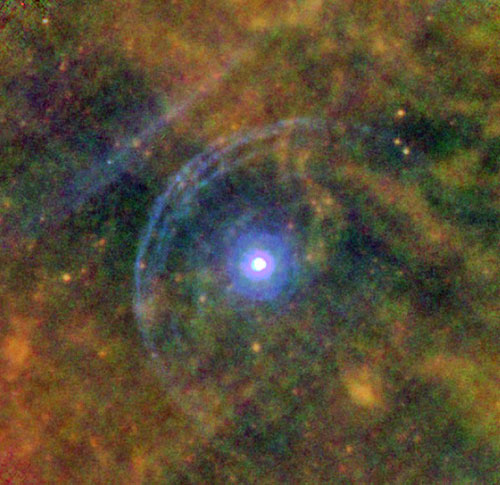|

by Rebecca Johnson
19 December 2016
from
McDonaldObservatory
Website
Famous Red Star Betelgeuse
is Spinning Faster than
Expected;
May Have Swallowed a Companion
100,000 Years Ago.
Astronomer J. Craig Wheeler of
The University of Texas at Austin thinks that
Betelgeuse, the
bright red star marking the shoulder of Orion, the hunter, may have
had a past that is more interesting than meets the eye.
Working with an international group of
undergraduate students, Wheeler has found evidence that the red
supergiant star may have been born with a companion star, and later
swallowed that star.
The research (The
Betelgeuse Project - Constraints from Rotation) is
published today in the journal Monthly Notices of the Royal
Astronomical Society.

This view of
Orion, the hunter,
was captured from
McDonald Observatory on November 20, 2016
by a DSLR camera
piggybacked on a three-inch telescope
for a 12-minute
exposure.
Supergiant star
Betelgeuse
forms the hunter's
bright orange shoulder at top left.
(Credit: Tom
Montemayor)
For such a well-known star, Betelgeuse is mysterious. Astronomers
know that it's a red supergiant, a massive star that is
nearing the
end of its life and so has bloated up to many times its original
size.
Someday it will explode as a supernova,
but no one knows when.
"It might be ten thousand years from
now, or it might be tomorrow night," Wheeler, a supernova
expert, said.
A new clue to the future of Betelgeuse
involves its rotation.
When a star inflates to become a
supergiant, its rotation should slow down.
"It's like the classic
spinning ice skater - not bringing her arms in, but opening her arms
up," Wheeler said.
As the skater opens her arms, she slows down. So,
too, should Betelgeuse's rotation have slowed as the star expanded.
But that is not what Wheeler's team
found.
"We cannot account for the rotation
of Betelgeuse," Wheeler said. "It's spinning 150 times faster
than any plausible single star just rotating and doing its
thing."
He directed a team of undergraduates
including Sarafina Nance, Manuel Diaz, and James
Sullivan of The University of Texas at Austin, as well as
visiting students from China and Greece, to study Betelgeuse with a
computer modeling program called MESA.
The students used
MESA to model Betelgeuse's rotation
for the first time.
Wheeler said in contemplating the star's puzzlingly fast rotation,
he began to speculate.
"Suppose Betelgeuse had a companion
when it was first born? And let's just suppose it is orbiting
around Betelgeuse at an orbit about the size that Betelgeuse is
now.
And then Betelgeuse turns into a red
supergiant and absorbs it - swallows it."
He explained that the companion star,
once swallowed, would transfer the angular momentum of its orbit
around Betelgeuse to that star's outer envelope , speeding
Betelgeuse's rotation.
Wheeler estimates that the companion star would have had about the
same mass as the Sun, in order to account for Betelgeuse's current
spin rate of 15 km/sec.
While an interesting idea, is there any evidence for this
swallowed-companion theory? In a word: perhaps.
If Betelgeuse did swallow a companion star, it's likely that the
interaction between the two would cause the supergiant to shoot some
matter out into space, Wheeler said.
Knowing how fast matter comes off of a red giant star, about 10
km/sec, Wheeler said he was able to roughly estimate how far from
Betelgeuse this matter should be today.
"And then I went to the literature,
in my naiveté, and read about Betelgeuse, and it turns out
there's a shell of matter sitting beyond Betelgeuse only a
little closer than what I had guessed," Wheeler said.

This 2012 infrared
image of Betelgeuse
by the orbiting
Herschel telescope
shows two shells of
interacting matter
on one side of the
star.
(Credit: L. Decin/University
of Leuven/ESA)
Infrared images taken of Betelgeuse in 2012 by Leen Decin of
the University of Leuven in Belgium with the orbiting
Herschel telescope show two shells
of interacting matter on one side of Betelgeuse.
Various interpretations exist:
Some say
that this matter is a bow shock created as Betelgeuse's atmosphere
pushes through the interstellar medium as it races through the
galaxy.
No one knows the origin with certainty.
But,
"the fact is," Wheeler said,
"there is evidence that Betelgeuse had some kind of commotion on
roughly this timescale" - that is, 100,000 years ago when the
star expanded into a red supergiant.
The swallowed companion theory could
explain both Betelgeuse's rapid rotation and this nearby matter.
Wheeler and his team of students are continuing their investigations
into this enigmatic star. Next, he says, they hope to probe
Betelgeuse using a technique called "asteroseismology" - looking for
sound waves impacting the surface of the star, to get clues to
what's happening deep inside its obscuring cocoon.
They will also use the MESA code to
better understand what would happen if Betelgeuse ate a companion
star.
Video
|



